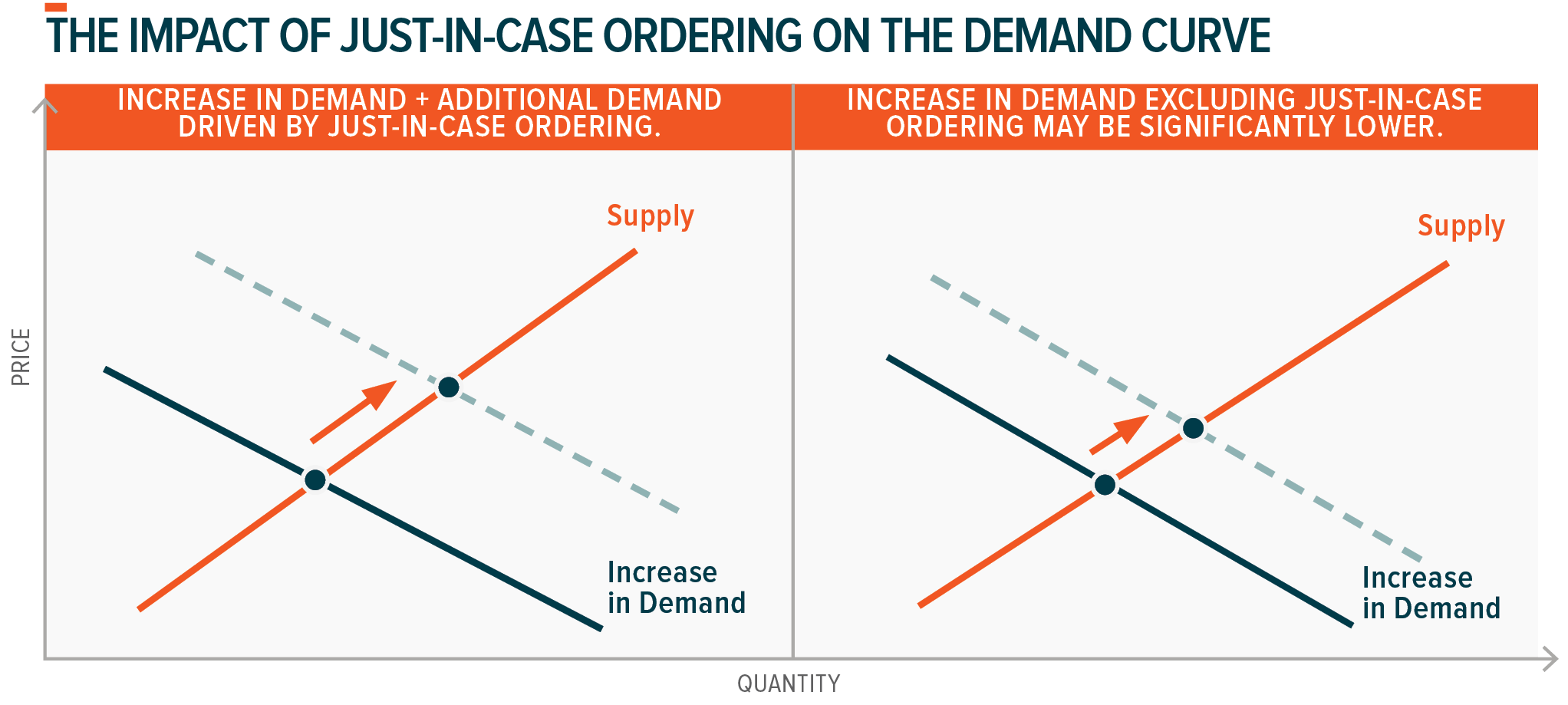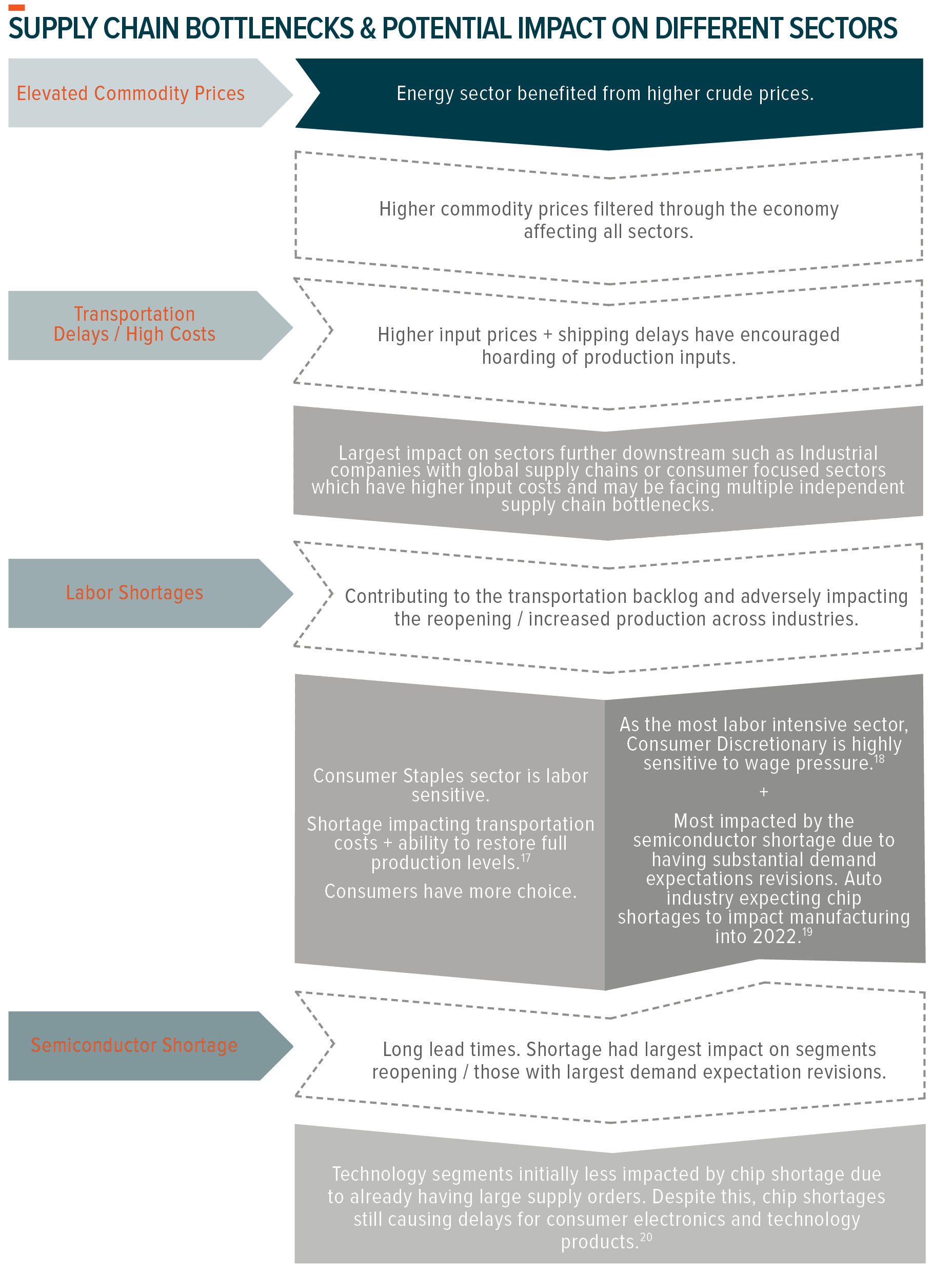The COVID-19 pandemic disrupted global supply chains and reveled their fragility. As the global economy re-opens and businesses struggle with material and labor shortages, increased demand for goods and services place additional pressure on tenuous supply chains. While supply constraints impact most of the economy, there are certain sectors which are either more or less affected by this disruption. Looking deeper into the current supply chain constraints is important for understanding the temporary or permanent nature of the current inflationary pressures and consequently how to position portfolios for this market environment.
Revised Demand Expectations and Supply Lead Times
The change in expected demand between April 2020 and April 2021 was unprecedented and supply chains struggled to keep up. While some supply chains are reasonably nimble to shifting demand pressures, we found that others can take months to resolve. The time it takes to create each product as well as existing capacity to increase production are factors that impact the nimbleness of supply chains. Global supply chains combined with just-in-time (JIT) manufacturing and ordering leaves minimal room for errors.
Far More than a Semi Story
Semiconductors are a good example of an industry with long lead times with high capacity utilization. They are the oxygen of our digital economy and their production affects many sectors. As illustrated in the graphic below, the current semiconductor shortage has implications across most sectors and industries, affecting products from cars and solar panels all the way to food products.
The current semiconductor chip shortage is partially due to sharp changes in expected demand. As the COVID lockdowns began, companies reduced their chip orders to avoid surplus inventory. Unlike prior economic contractions, there was a rapid increase in consumer demand for a whole swath of products that depend on semiconductor chips for their operation. In 2020, semiconductor demand increased 10.4% and demand for 2021 is forecast to expand a further 12.5%.1 Capacity utilization in the semiconductor industry typically runs at around 80%, with some facilities at between 90-100% of capacity.2 The inelasticity of chip production exacerbates the current supply shortage as it requires billions of dollars in capital investment and several years to open a new silicon chip facility: an expensive solution that will not have any effect on fulfilling short-to-medium term demand.
While the semiconductor shortage is currently the most discussed supply chain bottleneck, it is certainly not the only supply chain problem. The shortage of the raw materials, polyethylene, polypropylene and monoethylene are disrupting the supply chain for plastic manufacturing. This shortage has implications from smartphones and car manufacturing all the way to food packaging and exercise equipment.3 Moving goods around the globe has been one of the causes of supply chain constraints and increased costs of shipping is also having an impact. The Baltic Dry Index, an indicator of global shipping costs, has increased 143% YTD.4
![]()
Just-in-Case Driving Extra Demand
As a result of recent supply shortages, manufacturers have been forced to rethink their use of just-in-time supply chain management. Diminished faith in ultra-complex global supply chains are causing manufacturers to consider stockpiling certain raw materials and components that are believed to be vulnerable to future supply disruptions. This shift from just-in-time ordering and supply chain management to a just-in-case mindset has exacerbated the current increase in demand.
Elevated uncertainty surrounding expected demand resulted in companies ordering additional supplies, just-in-case. This process was repeated by many companies, thus stressing supply lines. Reasonably similar occurred with toilet paper and other key staples back in March 2020. This raises questions about the true level of increased demand. Is the elevated mismatch being driven by a sustained increase in demand, or is it partially driven by current uncertainties?
Lumber is a good example and has important implications for the inflation debate due to its impact on house prices. By mid-May, lumber prices increased by almost 180% on a year to date basis. During the rally in lumber prices, supplies were being hoarded by builders and retailers due to concerns regarding future supply.14 These hoarders have become sellers, and since the highs of May, lumber futures for July delivery declined 55%.15 This reflects the speed at which areas can shift from hoarding to surplus as demand expectations normalize.
Similarly, the Bloomberg Commodity Index pulled back in mid-June. Two factors contributed to this:
- The Federal Reserve (Fed) brought forward the date when they are likely to start increasing interest rates. This supported the value of the dollar while weighing on commodity prices.
- China, who accounts for 47% of the global consumption of refined base materials,16 indicated that they will begin selling some of their industrial metal stockpiles in batches as a way to dampen producer price increases that have been driving concerns over global inflation.
Reduced commodity prices are likely to lessen the inclination for businesses to hoard production inputs. Improved clarity on demand has the potential to ease some of the strain on supply chains.

Potential Impact on Different Sectors
Restarting the economy has been almost as disruptive as shutting it down. Dramatic changes in demand expectations have resulted in substantial mismatches between supply and demand. As you move down the supply chain, these mismatches and bottlenecks are accentuated. The graphic below outlines a few of the key supply chain disruptions and how they are impacting different sectors.

In our view, the Consumer Discretionary sector is likely to be the most impacted by the current supply chain constraints. This view is driven by two major supply chain pressures having a significant impact on a large portion of the sector.
- As the most labor-intensive sector, labor shortages and the potential for higher wages may have the largest impact on this sector.21 This has implications across the sector; from department stores and hospitality services all the way to e-commerce platforms.
- Typically, during an economic recession, consumers delay discretionary and durable purchases. As such, this is a sector that generally had a large downward revision in demand expectations during the first half of 2020. This had implications across the Consumer Discretionary sector from home appliance manufacturers all the way to auto manufacturers. Due to substantial revision to demand expectations, this sector has been one of the worst impacted by the semiconductor shortage.
But where there is disruption, there is also opportunity. The last year stress-tested global supply chains and revealed the need for improvement. The Industrials sector stands to benefit from increased capital expenditure as companies rethink their supply chains. While we believe this is a longer-term benefit that the Industrial sector is likely to enjoy, it is currently still adversely impacted by both raw material and labor shortages.
Sector Views
While supply chains constraints are an important consideration, there are numerous factors impacting our current sector views. The table below outlines these views.

 Michelle Cluver
Michelle Cluver